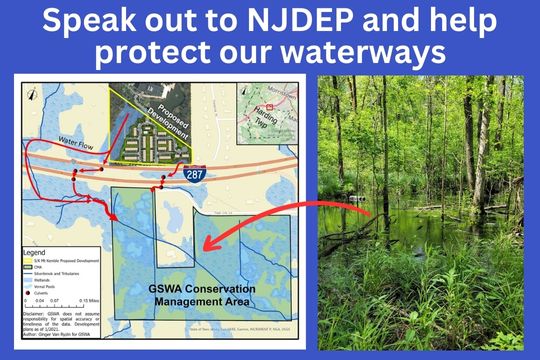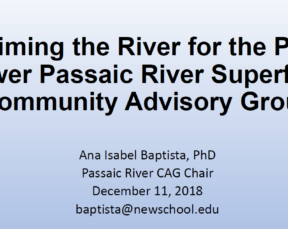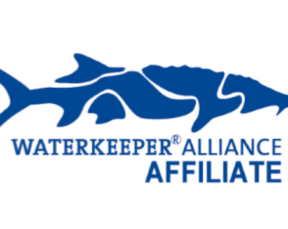GSWA’s February 23 action-alert webinar regarding the proposed S/K Mt. Kemble development plan on a 9.3-acre, forested parcel in Harding Twp. prompted much conversation and media coverage. The plan calls for the new construction of a 96-unit residential, multi-family condominium complex including affordable housing with a community clubhouse, playground, pool, and dog park. This plot of land flanks Route 287 on one side and the Mt. Kemble office complex on another side. The third side bumps up against wetlands which connect to GSWA’s 73-acre Conservation Management Area (CMA) under Route 287. The CMA contains sensitive wetland habitat for threatened and endangered species such as the wood turtle.
Following are an article that appeared in New Jersey Hills Media followed by and an Op-Ed published on MorristownGreen.com
Webinar stocks activists with verbal ammo
to protest proposed 98-unit Harding development
By Mike Condon, Staff Writer
February 28, 2023
HARDING TWP. – If you needed verbal ammunition to persuade the state Department of Environmental Protection (DEP) to reject a developer’s plans to construct 96 multi-family housing units near sensitive wetlands, the Great Swamp Watershed Association (GSWA) had it during its one-hour Zoom seminar on Thursday, Feb. 23.
There, participants- and there were some 60 online – were given a series of “talking points” that can be used when the DEP holds a public hearing on the application by KRE, Kushner Real Estate Group, to construct a residential housing facility adjacent to the Mount Kemble Corporate Park at 350 Mount Kemble Ave., and Route 287.
There are plans for building 96 multi-family condos between the corporate campus and highway. It’s about 15 acres in size and it is accessed through Morris Township, but the project is in Harding.
The Harding Township Planning Board approved the project in September of 2021, after the township reached a settlement with the Fair Share Housing Center to approve the project.
It’s officially known as the “KRE Project,” and its potential existence is raising the concerns of the GSWA.
In response to GSWA’s opposition and a barrage of public comments and requests, the DEP has scheduled a virtual public hearing on Thursday, March 9 to consider amending the Northeast water quality management plan.
The Thursday, Feb. 23 webinar was designed to raise public awareness and garner attention to the project, and also to focus public comments on issues the DEP will be looking at, including disturbances to the nearby Loantaka Brook.
GSWA Executive Director Sally Rubin began the hour-long session by saying that more than 100 had signed up ahead of time.
“They are talking about 96 condos. Sixteen of them will be affordable housing units. It’s 15 acres, and 9.3 of them will be developed,” she said.
“This is directly upstream from Tiger Lilly Lane and the GSWA. We have some very specific water quality concerns. We want to be able to explain those concerns and come prepared for the DEP on March 9,” she said, describing the meeting for the Zoom session.
Speakers included Elliott Ruga, policy director of the New Jersey Highlands Coalition, and Steve Souza, a consultant from Clean Waters Consulting. Hazel England, the GSWA’s director of education and outreach also spoke.
Ruga said that the crux of the developer’s application with the DEP is not the building project itself, but the availability, or lack thereof, of sewer utility.
“They want to establish a new sewer service area adjacent to the existing one that services that area,” he explained. “They want to expand. That’s why they have to go to the DEP,” he said.
They will have to adhere to the state wasterwater plan, he said, and will also have to meet federal water quality standards.
“This area is in the state’s Northeast Water Quality Management Plan. They want to amend that. It’s a rule change. They are trying to amend a fixed sewer coverage area. It’s a complicated rule change they are seeking,” he said.
“This is where the public can participate. The DEP wants comments. We’ve got a public hearing, and the DEP is very aware and on alert that people are watching this,” he said. “If no one was watching, they would just rubber stamp is through, but people have been really responsive. We are here tonight trying to help you (members of the public) formulate relevant comments,” he said.
“They (the applicant) have to show that this will have minimal effects to an environmentally sensitive area. Much of the area we are talking about is home to endangered species. There is endangered wildlife that has been identified on this site, so that is important,” he said.
Parcel Placement
One of the many things the DEP looks at, Ruga said, is whether the parcel is in wetlands, or, for example, the coastal planning area. “This development is not in the coastal planning area. But, Morris Township and Harding Township have been identified as endangered species habitats. In what is the proposed sewer service area, the Indiana Bat has been located,” he said.
The presence of the endangered wood turtle, he said, has also been verified.
“The question will be whether or not these habitats impact the assessment. The DEP has said previously that it will not be significant. But they always say that. These are breeding species which have been clearly identified on the site,” Ruga said.
“This is an area where you can comment,” he advised.
He also said the application is vulnerable due to the 2008 Highlands Master Plan.
“The DEP must ensure that no water allocation permits are issued in what the Highlands Master Plan identifies as a protected area. The Highlands Council (which sits in Chester and meets monthly) must approve any expansion of the water quality plan,” he said.
“The applicant has to satisfy the conditions of the Highlands plan. This project is in a location where the Highlands Council can comment to the DEP,” he said.
“Is this consistent with the Highlands Regional Master Plan?” he asked. “Morris Township is not a conforming municipality, but the Highlands rules still apply,” he said.
“They must follow it to be approved,” he said.
Since the project will use city water, Ruga said the well will be in the same sub watershed as the buildings. Wastewater, however, will be transferred to another sub watershed. “This is what is known as a depletive use of water. The Highlands Council will require indoor water conservation methods, but there will be no enforcement. They will say to use low flow plumbing, and to use Energy Star efficient equipment, but who is going to enforce that?” he asked.
“Who is going to enforce these mitigation measures. Are they really mitigating a depletive use of water. They can be challenged on that as well,” he said.
He said their plan must not only be approved, but must be fully implemented. “As of now, they just have a plan. They are a long way off. This is a very vulnerable part of their approval process,” he said.
Potential Impacts
Souza, meanwhile, cited impacts to Silver Brook and other waterways due to increased runoff. He said floods in the Silver Brook area are likely, in fact.
Increased pollutants, including phosphorous, which promotes plant growth, nitrogen and increased sediment will cause a disturbance to wetlands.
“This is an entire ecosystem that will be disturbed, including the wood turtle’s habitat, and this will cause more flooding of downstream properties,” he said.
“Woodlands will be replaced with rooftops, hardscape, pavement and lawn. There will be more runoff,” he said.
“Although runoff rate will be controlled, the total volume of runoff produced by every storm will increase,” he said, predicting a 40 percent increase in phosphorous, and a 70 percent increase in nitrogen, as a result of runoff.
“The project will implement a number of NJDEP Best Management Practices,” Souza said. “But it will still result in an unknown increase in heavy metals and petroleum hydrocarbons. This is bad news for water quality and the biota of Silver Brook,” he said.
He also said that 27,000 gallons of water, per day, will be transported out of the Silver Brook watershed. That water, in turn, will be discharged into the Loantaka Brook and Kitchell Pond. They are located in Morris Township and Morristown, respectively.
“Kitchell Pond is already experiencing intense algae blooms. And the GSWA has been testing Loantaka for over a decade,” Souza said. “This will bring a measurable change in water quality,” he said.
Harding’s Mt. Kemble Project: The Back Story
Water is Not the Only Concern
By Cathy Wilson, Ms. Catherine J. Wilson, Morris Township Deputy Mayor for Public Outreach
February 28, 2023
As you may know, the Great Swamp has issued a call for concerned citizens to raise their voices at a March 9th Public Hearing with NJDEP in opposition to a development project Harding has proposed at the bottom of the Mt. Kemble office complex in Morris Township.
Having followed this project closely since 2018 when Harding included it in their affordable housing settlement in court, I can tell you with certainty that, in addition to presenting significant environmental concerns, this site is a great illustration of everything that’s messed up about how affordable housing development works in New Jersey.
I’m viewing the Great Swamp’s widespread call for the public to attend the March 9th hearing with NJDEP as a valiant “Hail Mary” effort to stop a project that’s riddled with concerns – and not just about water.
Big picture: my impression of this project is that no one except the developer actually wants it.
For many reasons, this strikes me as a very “un-Harding-like” project. My own experience with Harding is that they truly value open space and environmental stewardship. Cramming 96 condos on to a pristine, environmentally-sensitive site that’s heavily wooded and loaded with wetlands just seems to me to be at odds with Harding’s values.
Perhaps that is why Harding’s own Planning Board found this project inconsistent with their Master Plan.
And further, why the developer had to sweeten the deal by making a $1,000,000 contribution to Harding’s affordable housing trust fund.
And further still, why Morris County’s Planning Board opined in its final Site Plan Report on this project that:
“Due to this property’s location next to Route 287 and the office park, it is better suited for a non-residential use. Locating a completely auto-centric development next to an interstate highway with no sound attenuation measures raises some environmental justice concerns, especially when it appears the majority of the low- and moderate-income units will be located closest to the highway.”
Were it not for Harding’s decision to include this project in its affordable-housing court settlement, and the legal hammers that decision evokes, this project would not be happening. Here’s the back story on why:
For starters, a good argument can be made that this is a Harding project in name only. Take Morris Township’s assistance out of the picture, and this project dies on the vine.
Consider even locational basics: while this project is technically located in Harding, due to the bizarre idiosyncrasies of NJ’s geography, this project sits on a site that is literally landlocked by Morris Township.
Short of knocking down homes of Harding’s own residents on two streets (Blackwell and Sand Springs), it’s impossible to access this site from within Harding’s own borders.
Going back to 2018, in a move that was prizewinning it its offensiveness, Harding passed an ordinance prohibiting access to this site from both of these streets (Blackwell and Sand Springs) – thus removing even the slightest fig-leaf of pretense that Harding might actually assume responsibility for providing access to their own site from their own town.
That decision left only two choices for ingress and egress to and from this site, both of which are located in Morris Township: one choice (to the east) was via a residential neighborhood on Frederick Place. The other choice, to the north, was via the office complex driveway.
In response to a request from Morris Township, Harding refused to include Frederick Place on the ordinance they had initiated to ban access from their own streets.
Adding insult to injury, in a saber-rattling move of his own, the developer actually went to far as to purchase a house on Frederick Place. Hummm…
But there’s more: due to this site’s location on Harding’s most remote outer edge, Harding is unable to serve this project with sewer service of its own. As with ingress and egress, responsibility for providing sewer service has fallen to Morris Township.
Were it not for the legal hammer of this site’s inclusion in Harding’s affordable housing settlement with the court (ties everyone’s hands; is nearly impossible to fight), Morris Township would not be providing the sewer service this project needs to survive.
The line in the sand for us was Frederick Place: NO WAY would Morris Township stand for ingress and egress through our residential neighborhood. This was a hill we were willing to die on in court – regardless of the cost or the outcome.
Harding’s need for Morris Township to provide sewer service and Morris Township’s need for the developer to stay away from Frederick Place was the key legal point codified in the Mutual Cooperation Agreement that Morris Township signed with the developer in December 2020.
With Frederick Place off the table, the only remaining access possibility to this site was the office complex driveway. Because the entire complex (including the driveway) is located in Morris Township, this precipitated a need for the developer to come before Morris Township’s Zoning Board for a use variance (residential development is a new use for this site).
Although the issue before Morris Township’s Zoning Board was limited to the driveway approval, that issue alone led Morris Township’s Zoning Board members to raise many of the same water concerns the Great Swamp is now encouraging the public to bring to NJDEP: what happens to all the new run-off this site will create? Where will it go? What impact will it have on ground water and nonpoint source pollution elsewhere?
Having walked this site myself (ironically when Harding’s Planning Board – to their credit – conducted an onsite meeting with the public) – a lasting impression has stuck with me ever since: is it REALLY okay to build a driveway on top of a pond that’s filled with pussy willows?? I’m not a hydrology expert, but doesn’t that raise some concerns??
Amazingly, although the Great Swamp borders this site just on the other side of 287 (and connects with it via the watershed’s underground water flow), no one had ever informed the Great Swamp that this project had even been proposed, let alone that it was in the near-final stage of the land-use approval process.
That lack of notification was legal but, in my opinion, disgraceful.
If the Great Swamp’s property line had been located within 200 feet of this site’s boundary, state law would have required Harding to notify the Great Swamp when this project came before Harding’s Planning Board – a great example, in my opinion, of the inadequacy of state law and the need to change the 200-foot notification provision. But that’s a story for another time…
It’s astonishing that the Great Swamp never heard anything about this project until it came before Morris Township’s Zoning Board. Needless to say, the applicant (aka – the developer) was not happy with the Great Swamp’s new-found involvement.
The applicant’s attorney went so far as to call for the removal of any member of Morris Township’s Zoning Board who had any connection whatsoever with the Great Swamp. Two Zoning Board members ended up being disqualified to participate further. In addition, at the attorney’s insistence, Morris Township’s Zoning Board had to re-start the entire public hearing process on this site.
The message from the applicant was clear: keep any influence from the Great Swamp completely separate and apart from any Board member who has a vote on this variance (not exactly a confidence-inspiring message in the applicant’s concern for the environmental impact of this project on its neighbors).
I find it significant that the Great Swamp opposes this project – and regrettable that their input is coming so late in this process. Their concerns and expertise have never been included in this application – until now.
The upcoming meeting on March 9th feels to me like something of a “High Noon” moment in deciding the fate of this project. Two environmental titans – NJDEP and the Great Swamp – coming together with concerned citizens to share information with each other about this project’s impact on our water supply.
NJDEP is the ultimate decision-maker here: their sign-off is required in order for this project to proceed.
The elephant in the room here is the way affordable housing development works in New Jersey. The need to provide affordable housing IS very important, but it feels to me (and many others) like the decision-making process that supports it has become a run-away train that’s taken on a life of its own.
I have my own thoughts about what could be done to improve this situation, but like the 200-foot notification rule, that’s a story for another day.
In the short run, this particular project is boiling down to a forced choice: which is more important to our community: preserving the natural integrity of our water supply or proceeding with an affordable housing project that’s taken on a “run-away train” character of its own?
The March 9th hearing will be an important opportunity for all of us to listen, learn, and contribute. After that, the ball will be in NJDEP’s court.
I think this has the markings of a landmark decision. Public participation in the March 9th hearing matters. It will be interesting to see what NJDEP decides.


